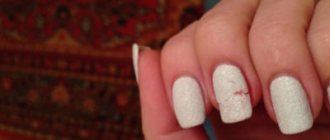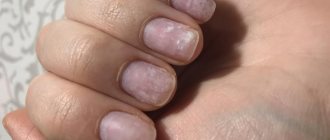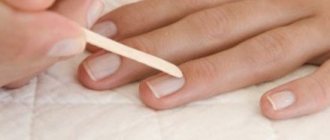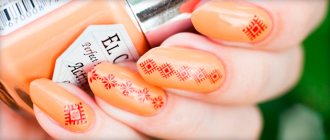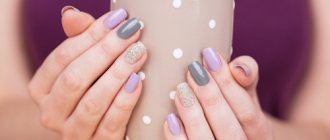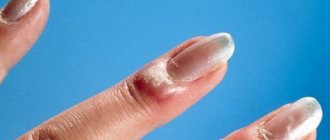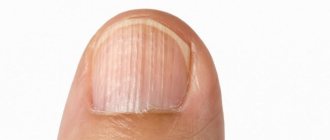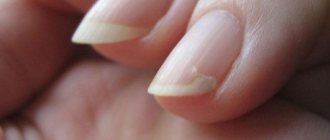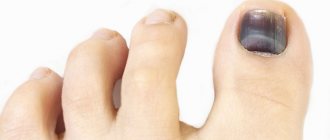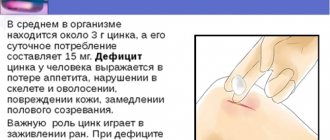Home page » Beauty » Nails
Author of the article
Svetlana Pavlikhina
Reading time: 6 minutes
AA
Manicure at home is always simple, painless, and safe. Using a minimal set of tools and varnishes that match the color, you can get your hands in order no worse than in a salon. There are many nuances that can ruin the result.
If the nail polish bubbles or layers unevenly, this is a consequence of improper application. Below are answers to the question of what to do for a perfect nail coating without bubbles and roughness.
Bubble Formation
Roughness forms during and after application if you vigorously shake the bottle with the product. This is done to thoroughly mix the liquid, even out its structure and color.
After intensive mixing, leave the varnish alone for 1-2 minutes, then begin the procedure.
Without proper preparation of the nail for painting, the coating may swell, so first the nails are degreased with a special liquid and polished with a fine-grained file. After such manipulations, the base fits perfectly on the nail.
If you wash your hands shortly before the procedure, moisture remains on the stratum corneum, and when applying layers, it does not allow the product to lie flat. It is necessary to dry your hands well shortly before applying the product .
The quality of the coating is also affected by the structure of the nail (unevenness, roughness, porosity).
The stratum corneum is deformed under the influence of the following factors:
- Hand and skin diseases (fungal diseases).
- Vitamin deficiency, deterioration of the skin and nail plate.
- Using aggressive detergents without gloves.
Under the influence of any chemical components, the nail becomes thinner, brittle and porous. The varnish coating is poorly applied and adheres to it, and bubbles appear after drying.
Poor quality materials
The choice of components for manicure must be taken with great care. The consequences of bad materials are not only bubbles, but also allergic reactions.
- Damaged varnish. If the bottle is not closed after use or the cap is not screwed on properly, moisture and air will get in. Oxygen is a catalyst for chemical reactions, as a result the composition of the coating changes. Here you have peeling and chipping of the coating, the appearance of bubbles when applying gel polish during drying and after the procedure.
- Use of incompatible materials. This happens when treated with compounds from different companies. Each manufacturer offers its own development of primers, degreasers, and varnishes. There may be antagonist components that enter into chemical reactions to form droplets of liquid or gas. Here is your answer why nail polish bubbles after application .
- Materials of questionable quality. These are expired gels, “cheap” China, counterfeits of well-known brands. Expired gels dry out and change consistency, which leads to cracking and bubbling of the manicure. Well, no one dares to say what is included in fakes and cheap materials.
Whatever the reasons for the appearance of bubbles on the nails after applying varnish , you want to get rid of the defect as quickly as possible. Yes, so as to preserve the manicure.
Reasons for the appearance of blisters after the coating dries
The formation of such deformation is influenced by 3 factors:
- layering the product multiple times;
- improper drying;
- use of oily nail and hand care products shortly before the procedure.
It is important to consider all these factors to create a neat manicure.
Reason 1: layering
If you layer the coating repeatedly, then after drying tubercles appear on the surface. It is not recommended to use more than 3 layers .
For the first application, use a base, then a color coating, then a fixer, glossy coating or top coat for gel varnishes.
If you apply more layers, their surface will become covered with bubbles, crack, or come off in layers the next day.
Reason 2: improper drying
You need to dry your nails under special lamps or in a calm state. Waving your arms is not recommended. When exposed to air, the varnish will form bubbles if the rules are not followed.
Reason 3: Using an oily hand product
It is not advisable to apply creams and oils before the manicure procedure.
This product and varnish products have a different structure. The cream always contains oils or fatty acids, petroleum jelly, glycerin, which are its basis. The reason for the appearance of roughness: these substances have poor contact with the varnish structure, covering the surface of the nail with a thin, greasy film, which does not allow the varnish to adhere to the upper stratum corneum, so irregularities appear.
Formation of tubercles after drying
Gel products and shellacs swell under the influence of a lamp when using a low-quality coating. Cheap dried products that are used many times deteriorate and bubble after drying.
If the manicure is done at home, the roughness is formed by dried particles of varnish. They form on the neck of the bottle after repeated use of the product.
Air appears when the liquid is vigorously shaken.
If drying was done with a hair dryer, blisters will certainly form on the surface. Intense waving of your arms while drying also provokes the formation of unevenness.
Washing hands and dishes immediately after the procedure contributes to the appearance of unevenness, because the varnish has not completely dried, all its layers have not “settled”, water can disrupt the structure and spoil the smooth coating.
They begin to do anything with their hands only after the product has completely dried: when pressed, the coating does not roll off, and no fingerprints remain on the surface.
Why do bubbles form?
Reasons for uneven application of nail polish:
- damaged dried varnish;
- hard or uneven brush;
- nail plate with deformation.
These factors affect the uniformity and gloss of the coating. To obtain an ideal surface, every point should be taken into account.
Varnish structure
When a product sits for a long time without being used or is poorly sealed, it dries out. A solvent may appear on the surface, the structure will delaminate, and such a coating may not lie evenly on the nail plate. It is not advisable to use it.
Brush
A thin brush with bent, stiff bristles or stuck pieces of dried polish may not cover your nails evenly.
If the contents of the bottle can still be used, then the brush should be replaced with a new, softer one, without adhering particles.
Nail
Bubbles form on an uneven, curved nail plate when applying the coating. To eliminate this defect, the nails should first be thoroughly treated with a soft file and degreased.
Afterwards, a thick consistency varnish is applied, which is used as a leveling agent. It is able to provide an even coating and prevent the formation of blisters.
Preparation for application
To avoid the formation of roughness when layering, the product should not be shaken before use. It is better to mix it and warm it up by rolling it between your palms. This way the coating will become uniform, elastic, and no blisters will appear.
Why does nail polish bubble when applied to nails?
Beautiful nails mean a neat manicure and an impeccable varnish finish. But sometimes it happens that it is this component of a manicure that lets a woman down. We are talking about a problem such as swelling of the varnish on the nail plates or, in other words, the varnish is bubbling. Why does this happen and what do experts advise in such cases? So, the causes of the problem and its solution.
Manicurists know why partial peeling of the varnish coating on nails occurs. There are a number of reasons for this:
- Shake the bottle of varnish before use. It is recommended to shake many cosmetic products before use. But this does not apply to varnish. Many women have the habit of shaking the jar very vigorously before opening and starting to paint their nails. At first, after this procedure, the coating will lie flat. And then it can slowly bubble on each nail. If you do a manicure yourself, it is better to just roll it in your palms. In general, high-quality varnishes in the bottle have balls that roll and mix the contents. Reputable cosmetic companies always produce nail polish with such balls. And then the movement of the balls ensures uniform mixing of the product. If you know that the product is not of very high quality, then it is better to simply hold it in hot water before use, but do not shake it. This will eliminate excess air in the bottle.
- The product has expired. This is the most common reason for polish bubbling. Old nail polish, like old mascara, cannot look perfect. With such helpers in your beauty arsenal, you can only harm yourself. If this is the case, then none is better.
- Wet or oily surface of the nail plate. When you do a water manicure, you need to carefully ensure that your hands and nails are completely dry and free of grease before applying varnish. Grease and moisture will not allow the manicure to be neat; the varnish coating will begin to bubble, if not immediately, then after a while. Before applying it, simply wipe your nails with nail polish remover or degreasing agent. And you should never apply cream to your hands before a manicure. After all, it is absorbed into the nails, which subsequently makes them look unattractive. But often the nails themselves, that is, by nature, are wet. Hands are also wet. In such cases, they need careful care, and a consultation with a manicurist would be a good idea. You may need to take multivitamins or undergo a course of manipulation in the salon.
- Thick layer of varnish. Often women apply second and third layers of coating without allowing the first to dry completely. In this case, bubbles cannot be avoided. Manicurists recommend applying the first layer at night, and the second in the morning.
- Change in varnish quality. If moisture gets into the bottle and it is left in the sun, then after applying the product a bubble effect may also appear.
- Using nail products from different manufacturers. Manicurists do not recommend using a base for varnish from one company, and the varnish itself from another. They can antagonize each other.
- Applying varnish without a base. The base protects the nails and makes the manicure look flawless. The varnish coating lays on it smoothly and neatly.
- Drying nails with a hairdryer. Sometimes girls' rush and lack of time forces them to resort to such a trick as drying their nail polish with a hairdryer. The hairdryer will dry your nails, but bubbles will form on the surface very quickly.
- Uneven surface of the nail plates. You should know that most often, irregularities and grooves on the nails appear as a sign of diseases of the internal organs. On such nails, bubbles may also appear after application of the coating.
What to do if the varnish bubbles?
Manicurists advise in such cases to follow certain rules:
- Store the bottle in a cool and dark place.
- Close the bottle tightly after use to prevent air from entering.
- It is imperative to remove the coating from the nail plates using products that do not contain acetone.
- Monitor the expiration dates of enamel and varnish.
- Give your nails a break for a few days before changing the polish. Don't wear polished manicure all the time.
- Take care of your nails and periodically care for them using baths.
How to prevent bubbles
A manicure takes a lot of time and it is very disappointing if, after all the efforts, the coating does not look perfect. To prevent this from happening, certain rules must be followed. It is easier to apply the varnish evenly at the very beginning than to correct emerging defects later.
Rules for layering the product (painting):
- The surface of the stratum corneum is prepared for the procedure - degreased. Oil-free nail polish remover is suitable. Then wipe dry. It is necessary to polish and level the surface with a special file.
- Before layering the varnish, the bottle is heated in your hands by rolling it; shaking the contents is not recommended. Then you need to remove dry particles from the neck of the bottle with a cotton swab moistened with acetone. Do this carefully so that fibers do not get into the bottle.
- To make the structure of the varnish uniform, you can place the bottle in warm water for 2 minutes before use.
- The base, coating and top are chosen from the same brand or manufacturer: products of the same line have the same composition, and they will not “argue” with each other.
- After application, the colorless base is allowed to dry thoroughly, only then can the colored layer be applied.
- All coatings are applied in a thin layer, while the brush is pressed tightly to the nail - this avoids the formation of bubbles.
- Do not paint the cuticle or skin of the finger.
- The coating is completed with a clear varnish or sealer.
- Gels and shellacs are dried using a special lamp. A product for home use based on acetone is dried in a calm state, without waving your hands, without blowing with a hairdryer or immersing your hands in water.
- Preparations for quick drying (sprays, gels) are used if there is no time for the fresh coating to dry naturally.
It is important not to use products that have expired.
Tips and tricks for manicure
An independent manicure procedure requires compliance with some rules that modern professionals adhere to.
Such tips help make the cosmetic procedure much easier, as well as ensure an elegant and successful result.
Important ! You need to do a manicure once a week. This is exactly the period of time that a high-quality varnish can withstand.
Let's look at the basic tips and tricks that allow you to create a spectacular manicure at home:
| Correct selection of tools | For good nail decoration you will need not only special varnishes, but also a nail file, scissors, tweezers, cotton pads, bath products and emollients. |
| Technique of the procedure | Consists of several stages: bath, cuticle removal, nail plate correction, application of coloring composition |
| Correct coloring | To ensure that the polish applies evenly, before each application of it to the nail, dip the brush into the bottle. |
| Correction during the procedure | It is necessary to have a cotton swab on hand so that in case of accidental contact with the skin, quickly eliminate the defect |
Do not forget that when applying nail polish there should be no hangnails or ingrown elements. This greatly complicates the work and contributes to poor-quality manicure.
Useful video
Share this post
- Related Posts
- How to grow long eyelashes, create visually thick ones with mascara, as well as warnings and tips
- Coffee scrub for body and face at home
- Using castor oil for eyelashes and eyebrows
- How to paint your nails according to Feng Shui to attract love, wealth and luck
- Lightening hair with chamomile at home
- Makeup for a red and burgundy dress
How to smooth out raised bumps
You can get rid of blisters and even out a fresh layer using topcoats designed for this purpose. They can dissolve the top uneven coating and fill it with their own structure.
When dry, the treated surface becomes absolutely smooth and even. This fixative is a quick and easy way to remove bubbles from nail polish.
